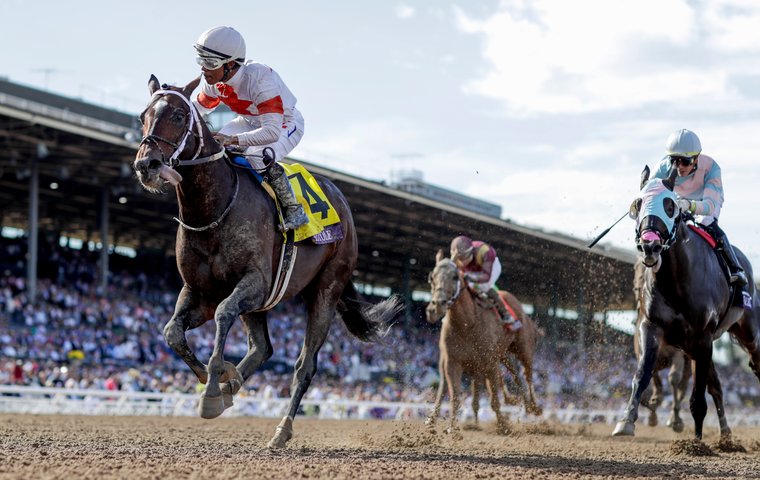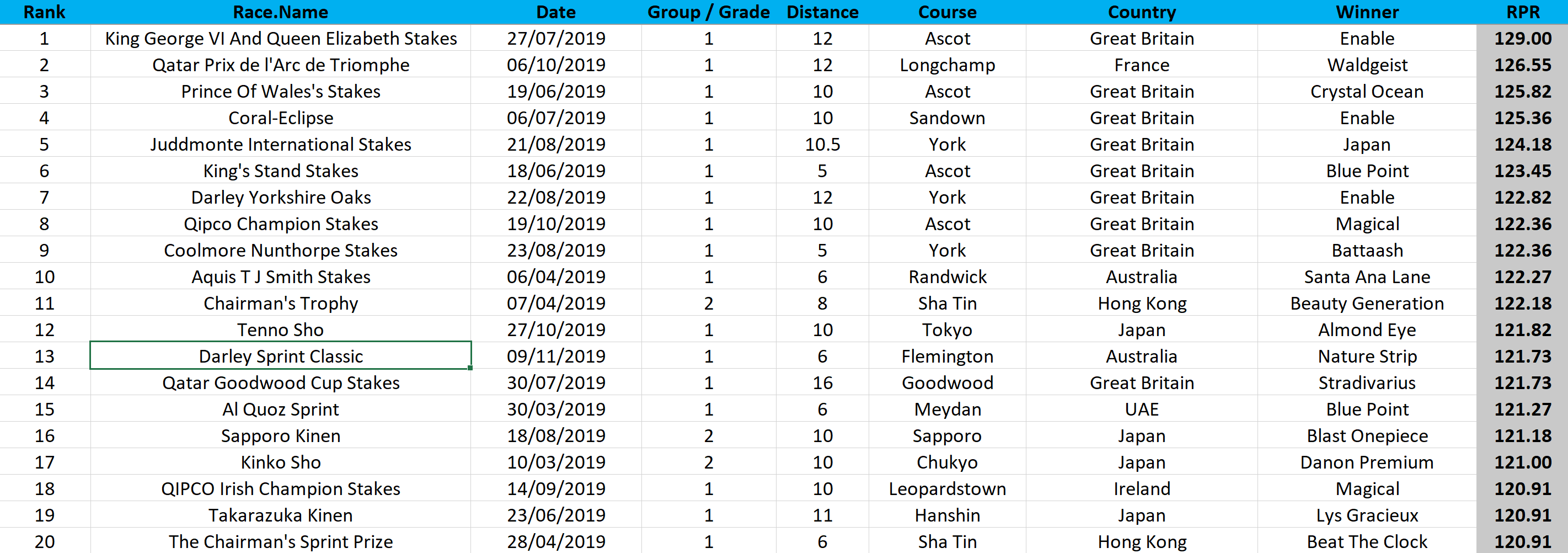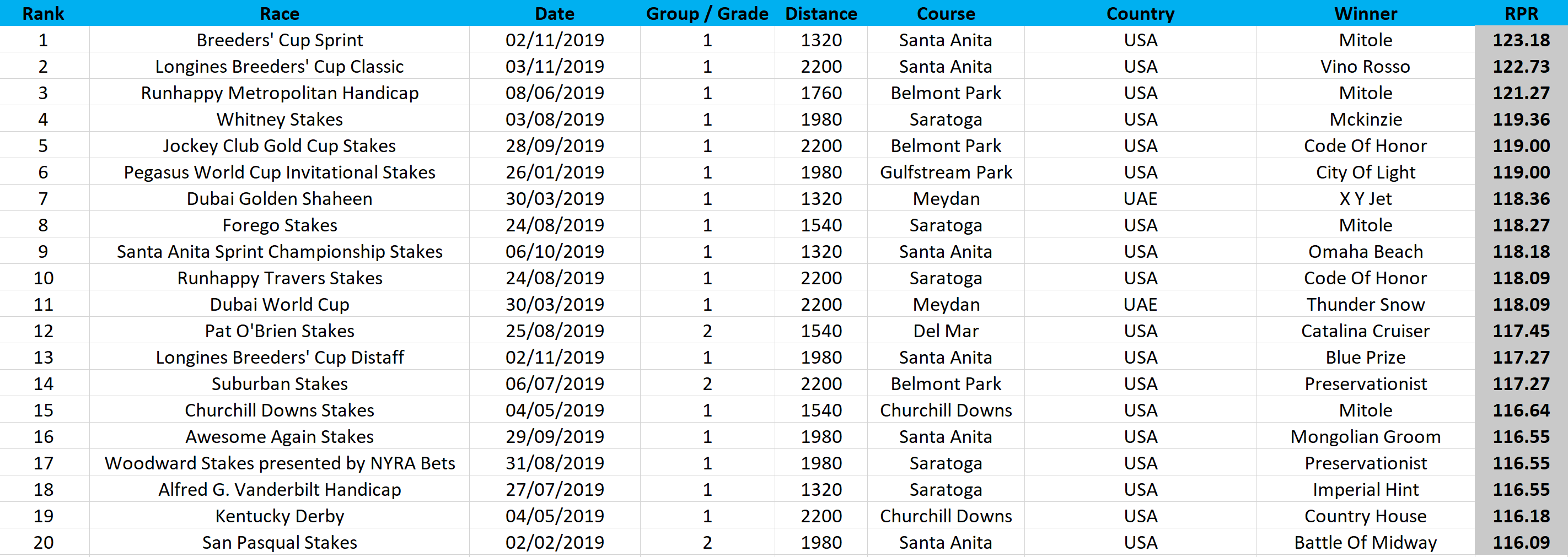
According to Racing Post Ratings (RPR) - a well-respected assessment of racehorse performance - the best races of 2019 featured a select group of middle-distance horses who did battle time and again. Enable, Crystal Ocean, Waldgeist and Magical - in that order - constitute the top of the pyramid and between them defined the highest-class events we saw this year.
Our method is to consider the first three finishers in every race only. The reason we don't go deeper than this that the performance rating of one horse in a race determines (and is determined by) the quality of proximity of those behind. Considering horses fourth or worse is therefore not necessary to understand the quality of a race because its standard and its depth is adequately captured by the ratings of the first three.
At the same time, in gauging the quality of a race, we ought to care more about the winner than the second, and the second more than the third. If you take a straight average of the first three, the third horse counts for as much as the winner, which is plainly wrong. So, following back-testing to discover how various weights predict future winners, we use weightings of 1, ½ and ⅓ by which we multiply the RPR before dividing by 1⅚ 1/6 (1 + ½ + ⅓).
There’s one more thing. In races open to both sexes in which females receive a weight allowance, it is imperative to add the allowance back in to the RPR before calculating this weighted average. The reason for this is that a filly running to 123 is effectively the same competitive force as a colt with 3lb more in the saddle running to 126. I would be plainly wrong not to adjust the RPRs in this way because a failure to do so would leave the annual rating of an open-sex race contingent on the sex of the runner that won it! Plainly, a colt beating a filly by a short head should imply the same quality of a race as the reverse.
With this methodology - which has always been consistent here in similar reporting - we present the top 20 races on turf and the top 20 races on dirt seen so far in 2019. Both classifications establish a clear hierarchy among the horses who made the placings, as can readily be seen.
TOP RACES ON TURF
We make the King George 1-2-3 Enable - Crystal Ocean - Waldgeist a better triumvirate that the Arc 1-2-3 Waldgeist - Enable - Sottsass. This is because Enable was in better form on King George day than she was in the Arc according to any set of reputable ratings, and because Crystal Ocean was missing from the Arc and he was arguably the second-best runner seen all season.
Although one could argue that there was more strength-in-depth in the Arc, our argument in the preamble deals with that. The performance ratings of the first three imply those behind, and in an end-of-season contest like the Arc, not every horse is still fresh to give its running. We care about how good the race actually was - not how good it looked on paper or how good the runners were who underperformed. And our research points to the method we use being hard to improve upon.
The dominance of the ‘Fab Four’ is underlined by the prominence in the race rankings of the Prince of Wales’s Stakes (Crystal Ocean - Magical - Waldgeist), the Coral-Eclipse (Enable - Magical - Regal Reality), the Juddmonte International (Japan - Crystal Ocean - Elarqam) and the Yorkshire Oaks (Enable - Magical - Lah Ti Dar).
Without fleshing out the details, the same concept of a hierarchy can be observed among the sprinters, where Blue Point and Bataash can jointly be considered at the pinnacle.
It's good to be reminded by the race rankings of the continual emergence of racing in Japan and Hong Kong, plus the continual quality of top-notch sprinting in Australia. Now Winx is not around, middle-distance racing in Australia takes a hit.
TOP RACES ON DIRT
Employing the same reasoning as for the turf hierarchy, it is obvious that a case should be made for Mitole as the Horse of the Year in the U.S. The Steve Asmussen-trained 4-year-old won five of his six starts, culminating in the Breeders’ Cup Sprint, in which he ran to a stellar RPR of 127 - and no less than four of those races appear here.
Again, those behind him help to define his superiority by their performances in other races. At the Breeders’ Cup, he beat Shancealot, who had earlier won a G2 that doesn't appear here by more than 12 lengths and who was twice beaten much more narrowly in G1 races, notably by Omaha Beach in the Santa Anita Sprint Championship. By the way, we continue to think the last-named runner is a brilliant horse in the making. He was given way too much to do in the Breeders’ Cup Dirt Mile as the winner Spun To Run set even fractions in front. Omaha Beach should be followed very closely from now on.
As we go down the table, so you should be able to see how cogent the ordering is.
In the Metropolitan Handicap, for instance, Mitole beat McKinzie, who won the fourth-best race on the list, the Whitney at Saratoga, and was second to Vino Rosso in the second-best race, the Breeders’ Cup Classic. In third in the Met Mile was Thunder Snow, who won the #11 race, the Dubai World Cup.
In turn, Vino Rosso passed the post first in the #5 race, the Jockey Club Gold Cup, but the race was awarded to Code Of Honour, who also won the #10 race, the Travers.
Other horses defeated by Mitole provide strong links to races all over the top 20, such as Forego runner-up Firenze Fire, who was also beaten a short-head by Alfred G. Vanderbilt winner Imperial Hint (third to X Y Jet in the #7 Golden Shaheen) in the G1 Vosburgh (not listed).
So, from the point of view of both turf and dirt, 2019 has been a highly formful year that makes a lot of sense from a who-beat-whom standpoint.




